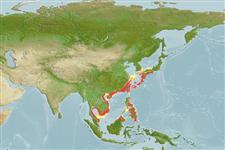Common names from other countries
>
Clupeiformes (Herrings) >
Dorosomatidae (Gizzard shads and sardinellas)
Etymology: Nematalosa: Greek, nema, -atos = filament + Latin, alausa = a fish cited by Ausonius and Latin, halec = pickle, dealing with the Greek word hals = salt; it is also the old Saxon name for shad = "alli" ; 1591 (Ref. 45335).
More on author: Regan.
Environment: milieu / climate zone / depth range / distribution range
Ecologie
marien benthopelagisch. Tropical; 37°N - 4°N, 98°E - 136°E (Ref. 188)
Western Pacific: Matsushima Bay, Sea of Japan southward to Taiwan Island, Hong Kong, the Philippines, and a single record from Gulf of Thailand.
Grootte / Gewicht / Leeftijd
Maturity: Lm ? range ? - ? cm
Max length : 19.0 cm SL mannelijk / geslacht onbekend; (Ref. 188)
Dorsale stekels (totaal) : 0; Anale stekels: 0; Anale zachte stralen: 17 - 26. Body generally more slender than in other species, belly with total 30 to 34 scutes. Anterior arm of pre-operculum with a fleshy triangle above, not covered by third infra-orbital bone (see N. come). Lower jaw strongly flared outward. Pectoral axillary scale well developed. Hind edge of scales distinctly toothed. A dark spot behind gill opening.
Schooling near shore over sand or mud, preferring warmer water than Konosirus punctatus. A filter-feeder; takes minute algae or organic matter. Breeds around May in Japanese waters.
Whitehead, P.J.P., 1985. FAO Species Catalogue. Vol. 7. Clupeoid fishes of the world (suborder Clupeoidei). An annotated and illustrated catalogue of the herrings, sardines, pilchards, sprats, shads, anchovies and wolf-herrings. FAO Fish. Synop. 125(7/1):1-303. Rome: FAO. (Ref. 188)
Status op de Rode Lijst van het IUCN (Ref. 130435)
CITES (Ref. 128078)
Not Evaluated
Gevaar voor de mens
Harmless
Gebruik door de mens
Visserij: van minder commercieel belang
Tools
Speciale rapporten
Download XML
Internetbronnen
Estimates based on models
Preferred temperature (Ref.
115969): 20.7 - 29, mean 27.4 (based on 340 cells).
Fylogenetische diversiteitsindex (Ref.
82804): PD
50 = 0.5005 [Uniqueness, from 0.5 = low to 2.0 = high].
Bayesian length-weight: a=0.00912 (0.00433 - 0.01920), b=3.04 (2.87 - 3.21), in cm Total Length, based on LWR estimates for this (Sub)family-body shape (Ref.
93245).
Trofisch niveau (Ref.
69278): 2.4 ±0.16 se; based on food items.
Weerstandsvermogen (Ref.
120179): Hoog, minimale populatieverdubbelingstijd minder dan 15 maanden (Preliminary K or Fecundity.).
Fishing Vulnerability (Ref.
59153): Low vulnerability (13 of 100).
